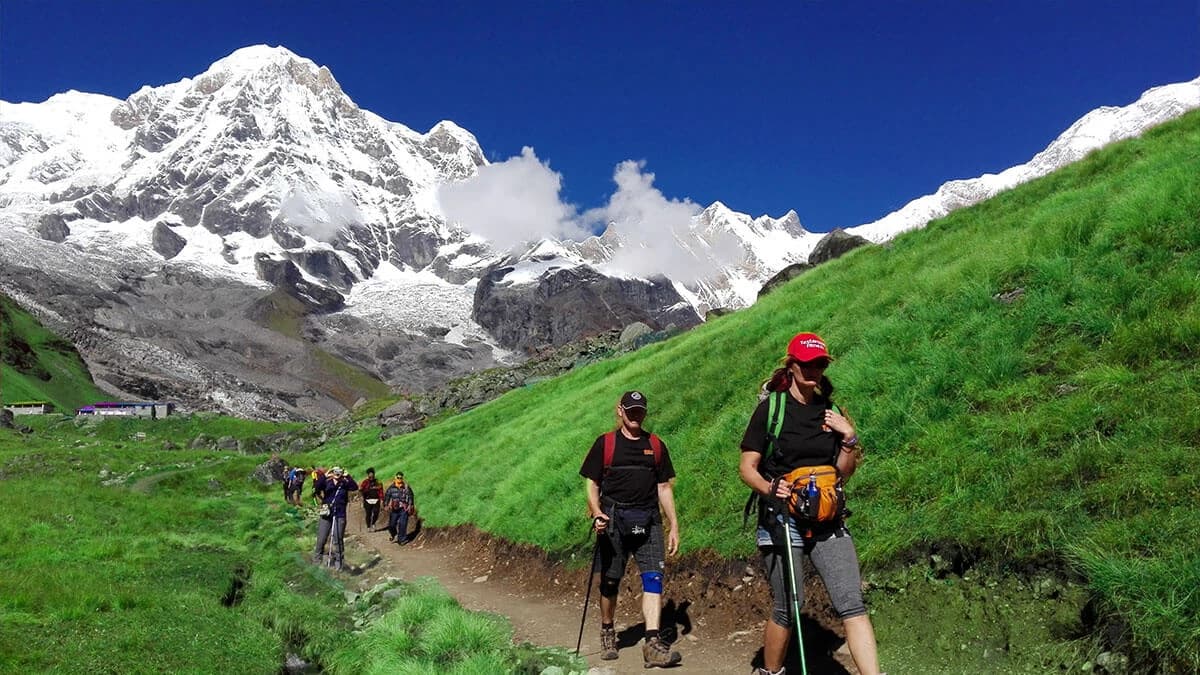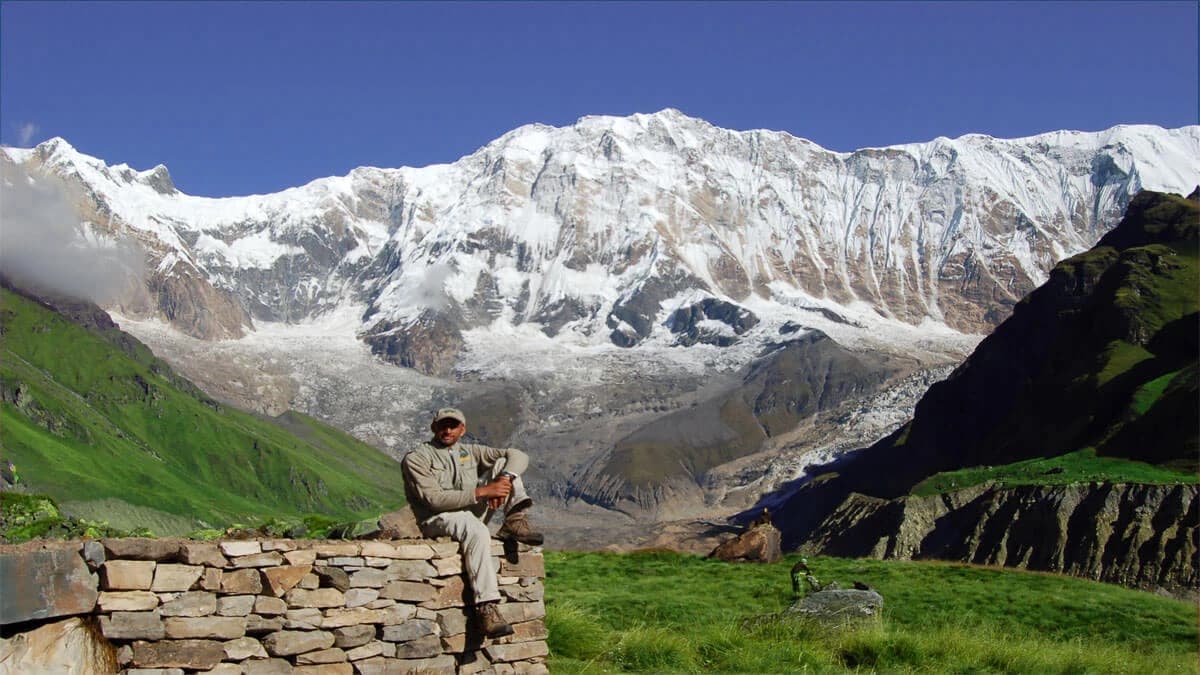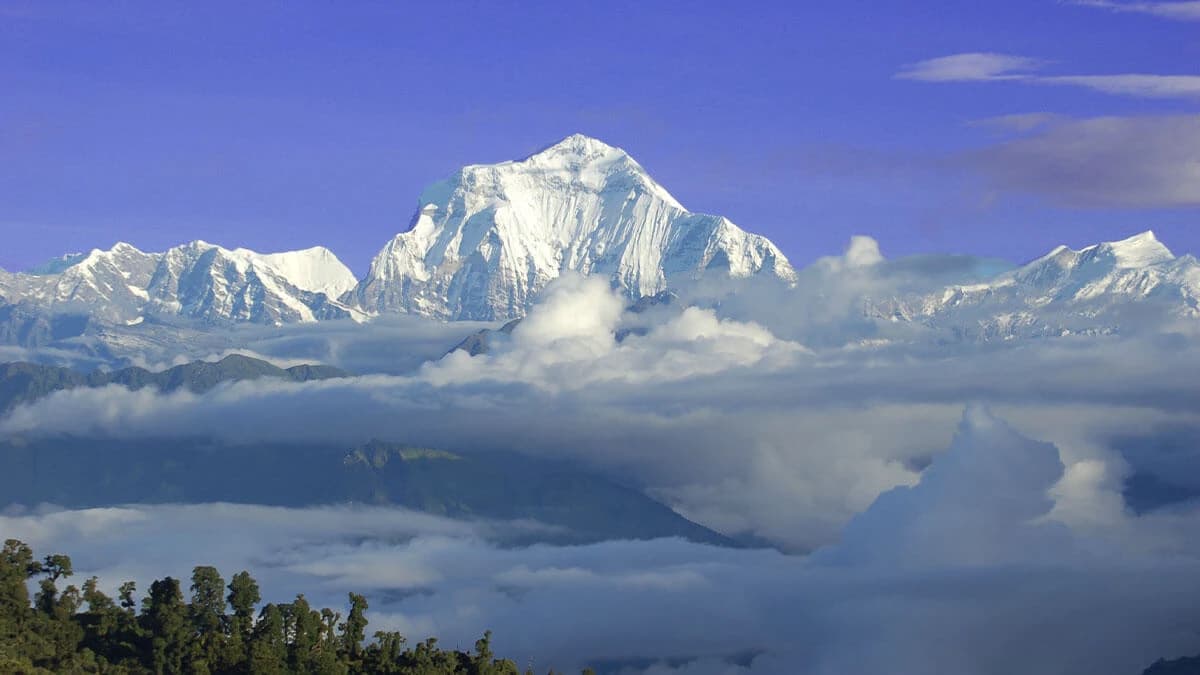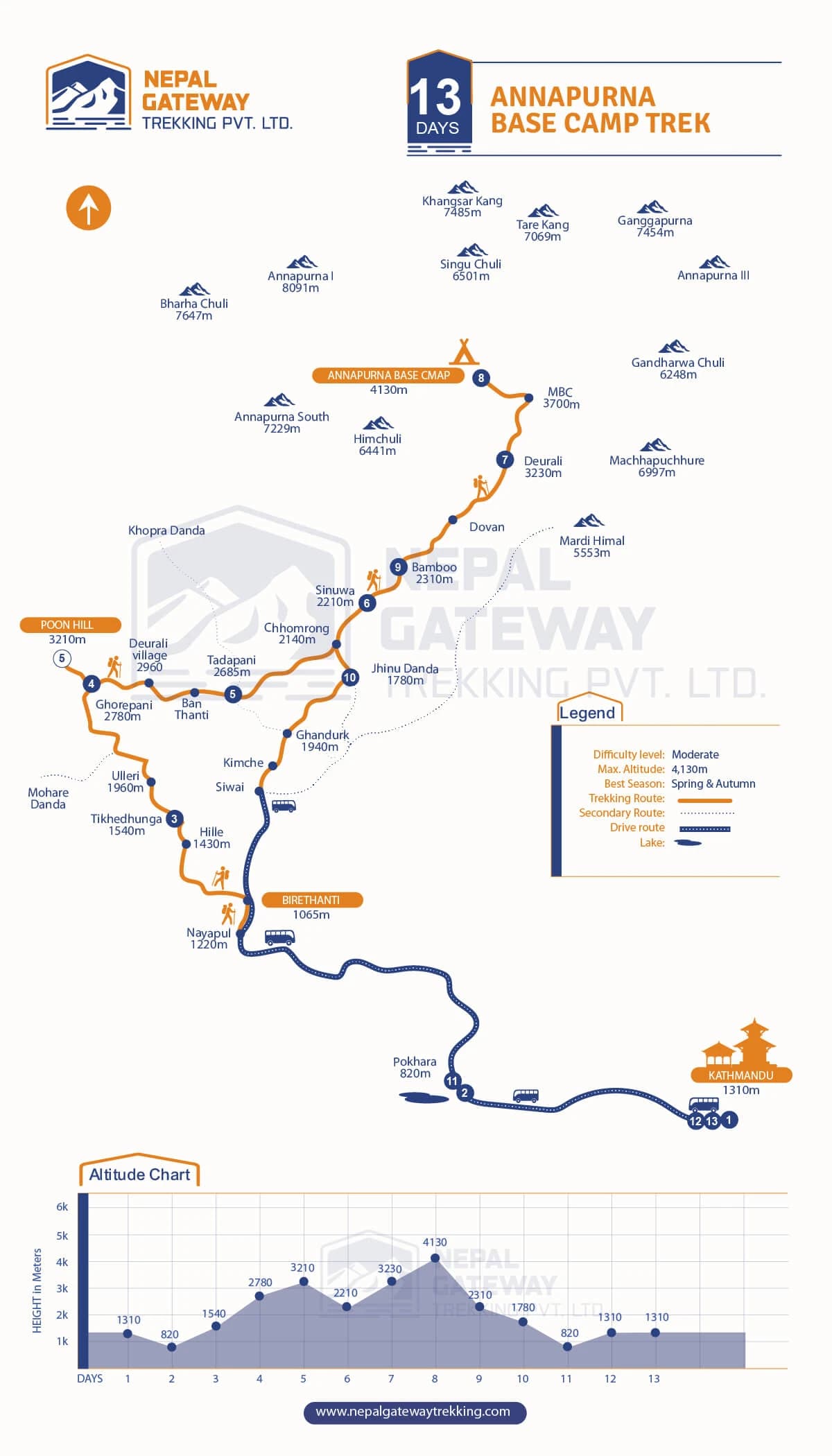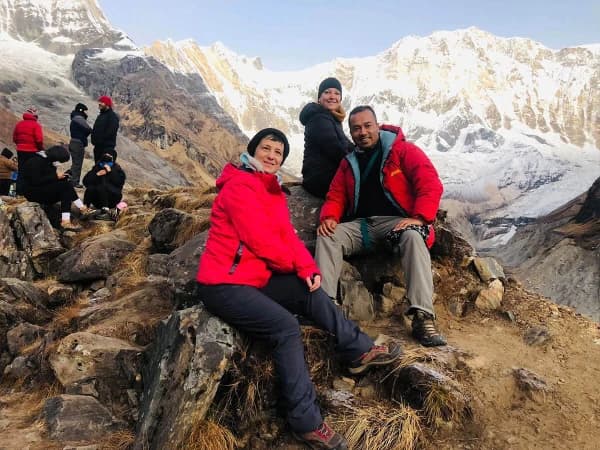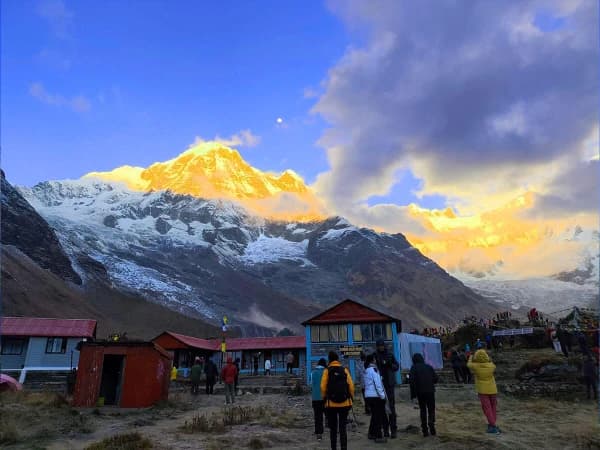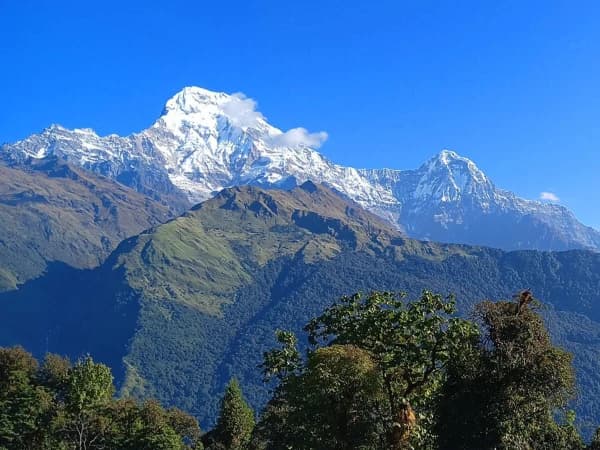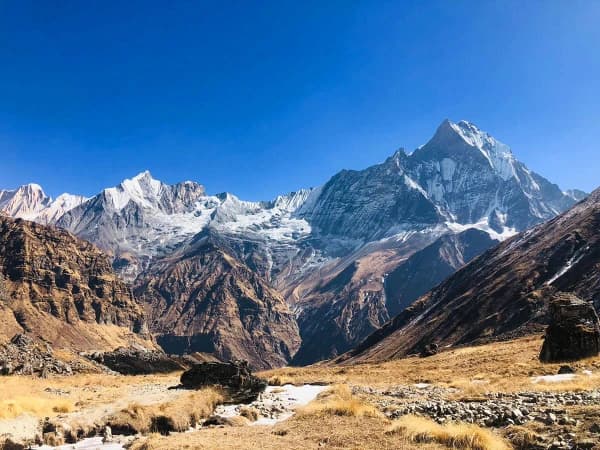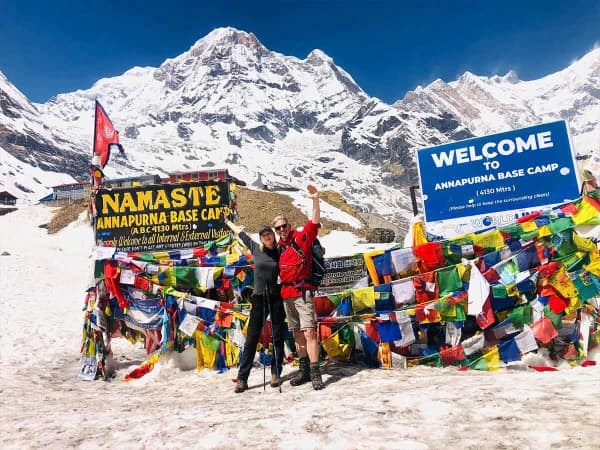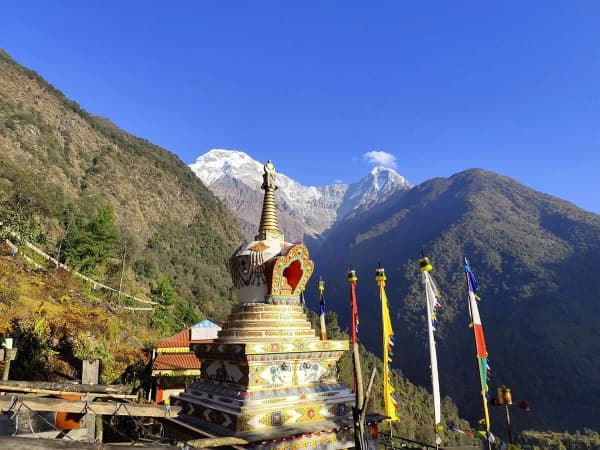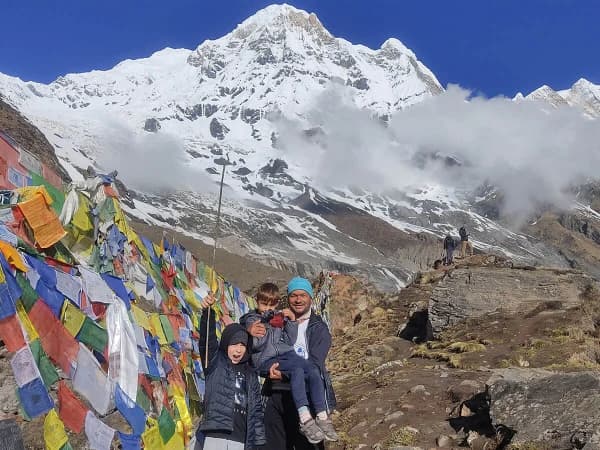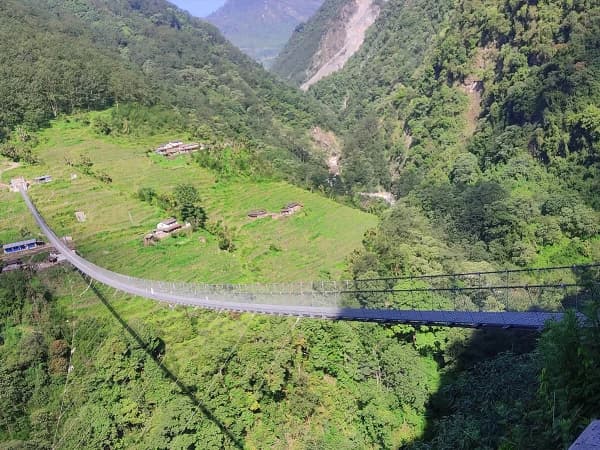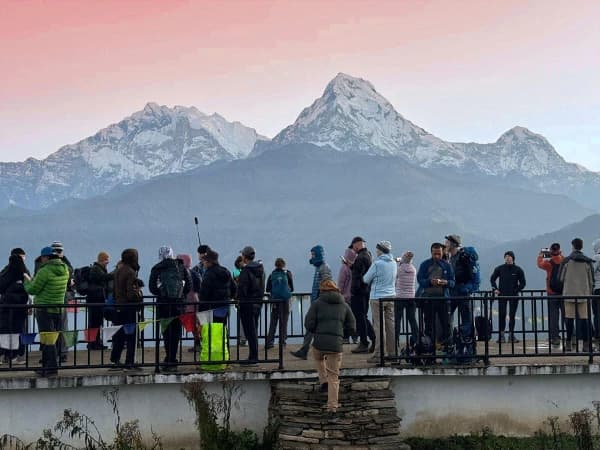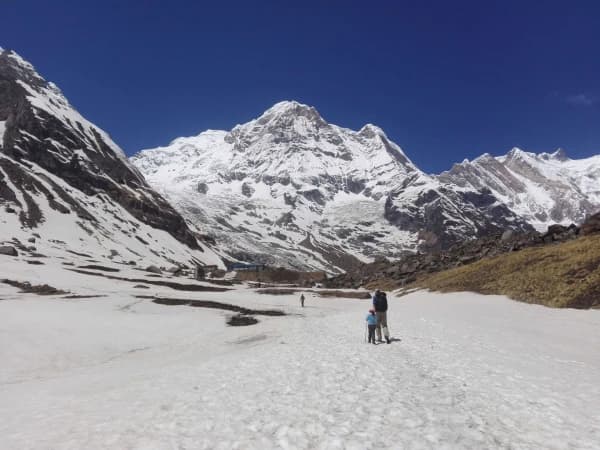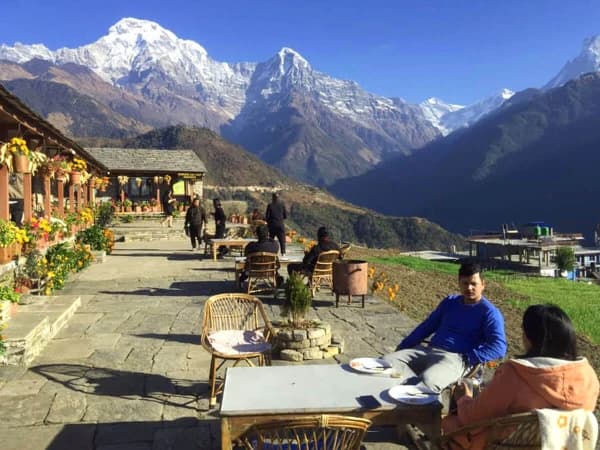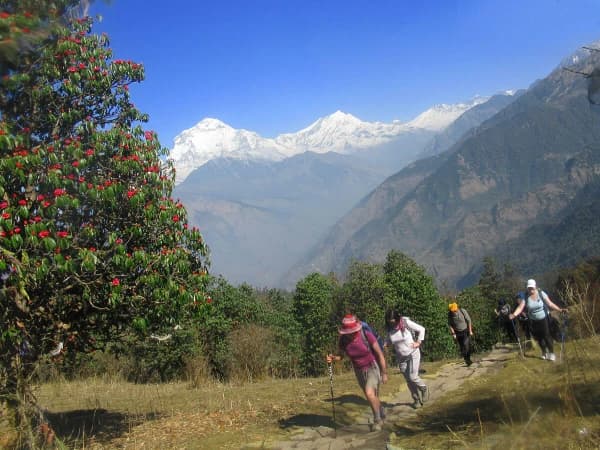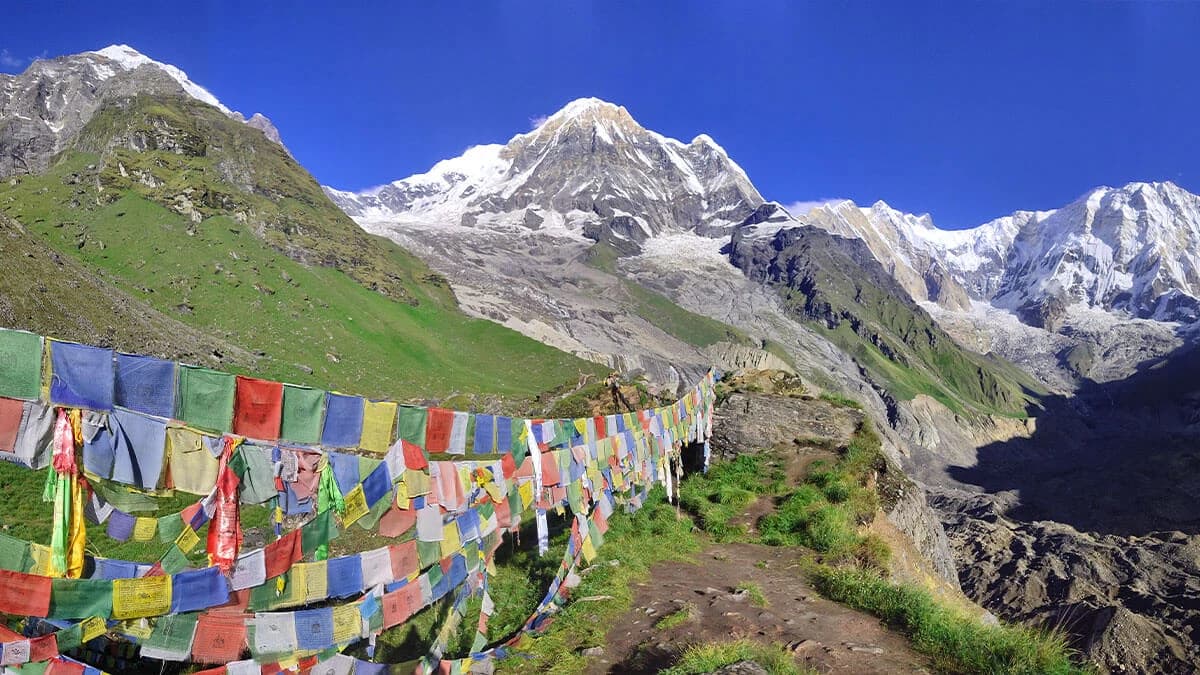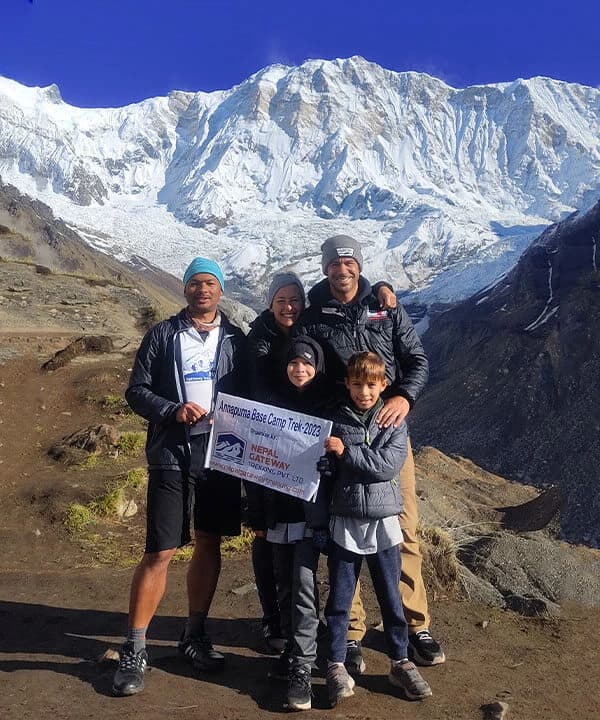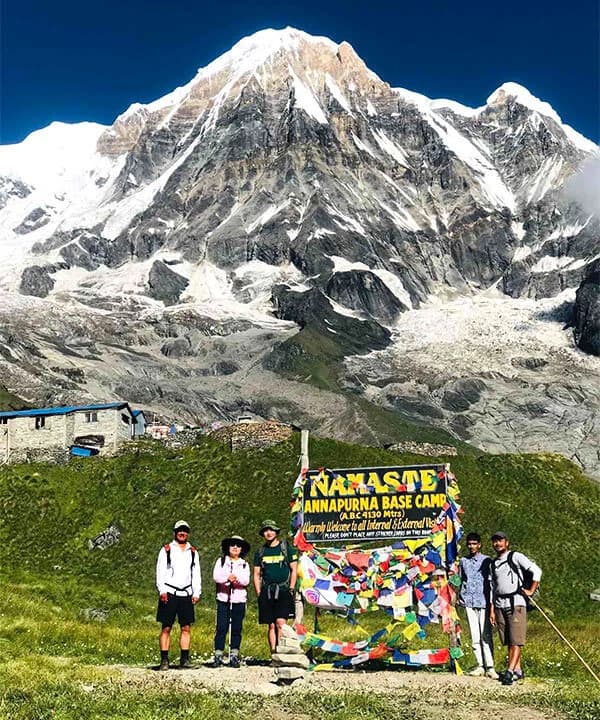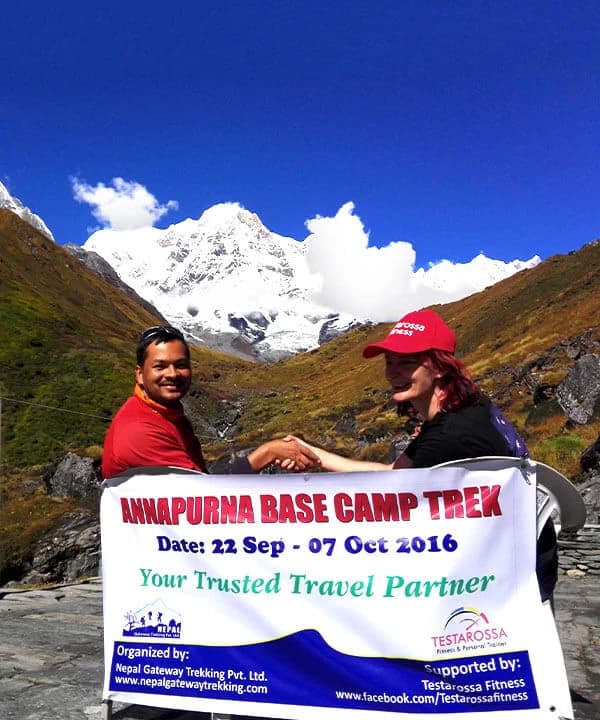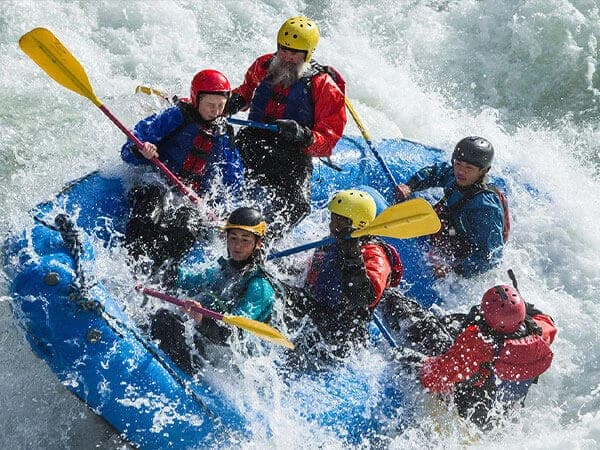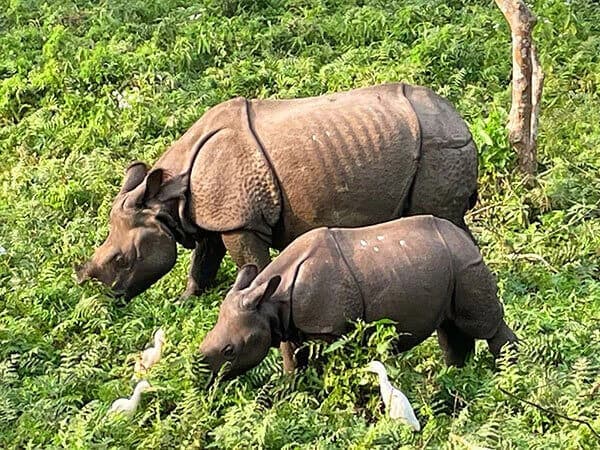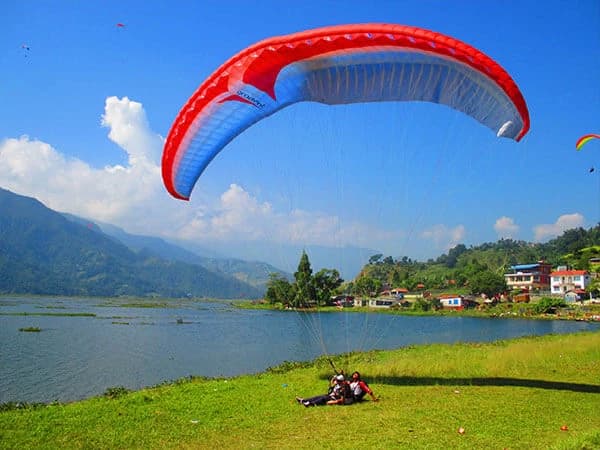The Annapurna Base Camp Trek is an unparalleled trek in the western Himalayas that showcases heavenly views of high mountains. It is an adventurous and once-in-a-lifetime experience of a peek into rich Nepali culture.
Annapurna Base Camp Trek
Annapurna Base Camp Trek stands as one of Nepal's most captivating mountain adventures. It is also known as the Annapurna Sanctuary Trek or ABC Trek. This remarkable journey takes you to see the incredible sunrise at Poon Hill to the stunning Annapurna Base Camp. Visiting charming places like Ghorepani, Chhomrong, and Machhapuchhre Base Camp (MBC) is remarkable, too.
The ABC trek follows ancient trade routes and trails used by local communities for centuries. The Annapurna region holds significant cultural and spiritual importance, as it lies within the Annapurna Conservation Area. ACAP is Nepal's first and largest conservation project, established in 1986. This protected area houses an array of wildlife, including elusive Himalayan tahr, langurs, and numerous colorful pheasants and mountain birds.
The natural diversity along the Annapurna Base Camp trail is simply extraordinary. The journey begins in lower regions with terraced rice fields, settlement villages, and subtropical forests. The trail gradually ascends through dense rhododendron forests that burst with color during the spring bloom.
As you climb higher, the landscape transforms into bamboo groves and finally opens into rocky glacial valleys. The trek ends at the Annapurna Sanctuary, a unique glacial basin surrounded by some of the world's tallest peaks. Here, you'll be encircled by massive mountains, including Annapurna I (8,091 m), Machhapuchhre (6,993 m), and Hiunchuli (6,441 m).
During the ABC trek, you'll encounter the warm hospitality of Nepal's mountain communities. The trek route passes through the traditional villages of the Gurung and Magar people. Walking through those villages offers intimate glimpses into their daily lives, customs, and lifestyles. This trekking region has a well-preserved natural environment and rich cultural heritage, making the Annapurna Base Camp hike unique.
The Major Highlights of Annapurna Base Camp Trek
- Spot diverse wildlife in the Annapurna Conservation Area, including Himalayan tahr and pheasants.
- Experience the rich culture and traditions of Gurung, Magar, and Thakali communities.
- Witness a magical sunrise over the Annapurna and Dhaulagiri ranges from Poon Hill.
- Trek through diverse landscapes, including terraced fields, rhododendron forests, and alpine meadows.
- Visit Machhapuchhre Base Camp (3,700 m), a tranquil stop with incredible mountain scenery.
- Witness impressive views of the Annapurna massif and other majestic peaks like Hiunchuli, Gangapurna, and Machhapuchhre (Fishtail).
- Trek to the Annapurna base camp of the world's tenth-highest peak, Mt. Annapurna (8,091 m).
- Witness unforgettable sunrises over the snow-capped mountains, painting the sky in orange, pink, and gold hues.
- Discover the serene Annapurna Sanctuary, a natural amphitheater surrounded by towering mountains.
- Relax in the natural hot springs at Jhinu Danda after your trek.
- Follow a well-marked ABC trail accessible to both beginner and experienced trekkers.
- Explore the serene city of lakes—Pokhara.
Annapurna Base Camp Route Overview
Your Annapurna Base Camp Trekking begins with an early morning bus journey from Kathmandu to Pokhara. Pokhara is a beautiful lakeside city offering fantastic mountain scenery. After spending a night in Pokhara, you'll drive to Nayapul the following day, where your trekking adventures officially start.
The first trek day takes you from Nayapul to Tikhedhunga, walking alongside the Modi River. You'll cross suspension bridges and pass through lovely settlement villages and picturesque terraced fields.
The following day leads you to Ghorepani through dense rhododendrons and bamboo forests. Ghorepani, a traditional Gurung village, rewards you with spectacular views of Annapurna, Dhaulagiri, Nilgiri, and Machhapuchhre peaks. The next morning brings an early hike to Poon Hill for a magical sunrise over the Himalayas. After soaking in the panoramic mountain vistas, you'll trek to Tadapani for overnight.
The 13-day Annapurna Base Camp trek itinerary continues through the charming village of Chomrong to Sinuwa. This challenging day involves descending over 2000 stone steps in Chomrong Valley, crossing a swing bridge, and making a steep climb up to Sinuwa. Along the way, you'll enjoy sweeping views of the Annapurna massif and Machhapuchhre. The next stretch takes you from Sinuwa to Dovan, descending through bamboo forests and passing numerous waterfalls.
Moving forward, you'll hike through Himalaya village to reach Deurali. This section features two massive waterfalls offering perfect rest spots, a large overhanging rock known as Hinku Cave, and several water crossings. The ABC trail follows a narrow gorge along the Modi Khola Glacier Valley.
The next leg brings you to Machhapuchhre Base Camp. MBC relishes appealing views of Machhapuchhre Peak towering to the east and the Annapurna range rising to the west.
The journey continues to Annapurna Base Camp (ABC). You'll walk close to Annapurna glaciers and gently climb upward past scattered rocks and icy streams until you reach ABC. From the base camp, you'll get jaw-dropping vistas of Hiunchuli, Annapurna South, Annapurna I, Gangapurna, and Machhapuchhre.
At ABC, as evening descends, you'll witness a magical display of stars twinkling above the snow-capped peaks. It is an unforgettable night panorama of the Himalayas. The next day, you'll wake before dawn to see one of the Annapurna Base Camp trek's most spectacular moments. The golden sunrise slowly illuminated the mighty Annapurna range, painting the peaks in brilliant shades of orange and pink.
Beginning your descent, you'll walk back to Bamboo, where you can enjoy authentic local cuisine with unique bamboo-infused flavors. The following day, take to Jhinu Danda, where you can soothe your tired muscles in natural hot springs. After a short trek the next day, you'll drive back to Pokhara from Jhinu. The final day brings a scenic bus ride back to Kathmandu, marking the end of an incredible Annapurna base camp trek before you catch your flight home.
Why Choose Nepal Gateway Trekking for the Annapurna Base Camp Trekking?
Expert Local Guides and Safety
- Licensed English-speaking guides with more than a decade of experience
- Comprehensive first-aid knowledge and altitude sickness prevention
- 24/7 emergency support throughout your trek
Customized Trek Experience
- Flexible ABC trek itineraries for all fitness levels (7-14 days available)
- Small group sizes (maximum eight trekkers)
- Acclimatization days included for safety
Premium Service and Comfort
- Quality teahouse accommodation booking
- Nutritious meals from local kitchens
- Porter service
- All ABC trekking permits and paperwork are handled
Sustainable Trekking
- Eco-friendly practices
- Local community support initiatives
- Fair wages for porters and staff
- Cultural preservation efforts
Best Value Guarantee
- Competitive prices starting from $940
- No hidden costs
- Early bird and group discounts
- Free trek preparation guide
Added Benefits
- Complimentary airport transfers
- Photo session at Annapurna Base Camp
- Trek certificate upon completion
Itinerary
This is our standard and recommended Annapurna Base Camp Trek itinerary.
Welcome to Nepal! When you land at Kathmandu Airport, our friendly staff from Nepal Gateway Trekking will meet you at the arrival gate. They will hold a sign with your name. After collecting your bags and going through immigration, we'll take you to the hotel. You can rest and freshen up there.
Later in the day, you'll meet our manager to brief the program and address your needs. Then, you meet the trekking guide. The guide will tell you about the ABC trek details and check your trekking gear. If you need any gear, you can buy or rent it in the Thamel area, which has many tourist shops.
In the evening, have dinner and then return to the hotel. Pack your bag tonight because tomorrow you'll leave early for Pokhara.
Today, you'll start the ABC trekking journey with a scenic drive from Kathmandu to Pokhara by tourist bus. This comfortable bus ride takes 6-7 hours, passing through vibrant landscapes, terraced fields, and small villages along the Trishuli River. The bus makes 2-3 stops for breakfast, lunch, and restroom breaks.
Enjoy the views of lush hills and distant mountains as you head toward the lakeside city of Pokhara. Upon arrival, the guide will transfer you to the hotel. Evening free to explore Pokhara's charming streets, cafes, and serene Phewa Lake.
Retire to bed early, as tomorrow you start your journey to ABC with an early morning drive to Nayapul, a trailhead for the ABC trek.
After breakfast, drive about 1.5 hours from Pokhara to Nayapul, where the Annapurna Base Camp hiking begins. At Birethanti, your guide will handle the Annapurna Conservation Area Project (ACAP) permit to check. The trail follows the Modi River, passing through the charming villages of Birethanti, Sudame, and Hille.
You'll see splendid terraced fields carved into the mountainsides and traditional stone houses along the way. From Hille, the trail climbs steeply upward. Cross several suspension bridges over rushing rivers and walk through small farming villages until you reach Tikhe Dhunga.
Today's trek begins with the famous climb up 3,200 stone steps to reach Ulleri village. Though challenging, the climb rewards you with spectacular views of terraced hillsides and the deep valley below. The trail continues through small settlements, offering staggering views of Annapurna South and Machhapuchhre (the Fishtail) peak.
After passing Banthanti village, the path turns into beautiful rhododendron forests, bursting with pink and red blooms in springtime. The trail becomes more rugged here, with rocks and tree roots.
After reaching the picturesque mountain village of Nangethanti, continue along a mixed dirt and stone path for about 1.5 hours until you reach the bustling settlement of Ghorepani. After the permit check, proceed from Lower Ghorepani to your overnight stop in Upper Ghorepani.
Today you'll wake up early for the hike to Poon Hill. Poon Hill is one of the best viewpoints for the sunrise over the high snow-capped peaks. The viewpoint offers 360-degree sweeping views of the Annapurna and Dhaulagiri Himalayan ranges. Witness an unforgettable sunrise as the first golden rays touch the snow-capped peaks.
The mountains gradually come alive, bathed in warm hues of orange and pink—a magical scene against the crisp morning sky. After taking in this highlight of the ABC trek, return to Ghorepani for breakfast.
Then, begin your trek towards Tadapani. The walk is relaxing as you cross a ridge line in the forest, with great angles of Annapurna South and Machhapuchhre. Continue the downhill trek, following a stream and passing by large boulders. After around 1.5 hours, you'll reach the village of Tadapani.
As you leave Tadapani, you'll officially begin the trek on the Annapurna Base Camp trail, marking the completion of the first half of the Poon Hill trek. The path winds through Kimrong and leads to the dramatic Chomrong Pass, with the magnificent Annapurna range as your constant companion.
The trail brings you to Chomrong, one of the Annapurna region's largest and most lovely Gurung villages. This bustling settlement serves as a central hub for trekkers.
You must stop at the tourist checkpoint to show your ABC trekking permits and documents here. After Chomrong, the trail descends dramatically via 2,000+ stone steps to reach the Chomrong River below. Crossing the river on a long suspension bridge, you'll face a challenging uphill climb out of the valley.
After roughly 45 minutes of steep ascent, you reach Lower Sinuwa. You can continue to Upper Sinuwa, which sits 150 m higher. However, be prepared for a steep climb between these two villages.
Start your journey from Sinuwa, enjoying an amusing close-up glance of Mt. Fishtail. After a couple of hours, reach Khuldigar and descend steeply to Bamboo. The trail then goes through lush forests filled with roots, rocks, and a magical atmosphere. Continue to Dovan, offering stunning views of Macchapuchhre and Annapurna III.
After a rest, hike uphill to Himalaya, passing dense forests, waterfalls, and moss-covered boulders. Explore a sprawling waterfall before a steep climb to Himalaya, the last village before Deurali. This trekking section is one of the most challenging days on your Annapurna Base Camp trek itinerary.
From Himalaya to Deurali, the trail includes gradual inclines, stair ascents, and a water crossing. You'll pass Hinku Cave (3,170 m), drier forests, and sheer cliffs with a waterfall before reaching Deurali.
Starting today's hike, you'll walk carefully through an avalanche-risk area and reach Machhapuchhre Base Camp (MBC). At MBC, rest and ponder the mind-blowing Machhapuchhre Peak (6,997 m). After MBC, everything changes—there are no more plants or trees, just snow and wide paths that curve through the valley.
You'll see the tall Annapurna mountains playing hide and seek with clouds. The last part of ABC is a steady uphill walk. You'll see the ABC lodges from far away, but don't get too excited—they're farther than they look! It'll take about 2.5 hours from MBC.
When you finally reach the base camp, you'll see one of the world's most picture-perfect landscapes: a 360-degree panorama of the towering Himalayas, including the entire Annapurna range.
Today starts with an early morning wake-up to watch the sunrise. The sight is magical as the first light hits the Annapurna peaks, turning them golden. The morning view from the base camp is truly unforgettable. Take a short walk to the viewpoint after sunrise.
Here, you'll see the massive south face of Annapurna I up close. The view includes other peaks—Hiunchuli, Khangsar Kang, Gangapurna, Annapurna III, and Machhapuchhre—in a 360-degree panorama.
Enjoy breakfast surrounded by these stunning mountains. The trek back to Bamboo goes through the same path you climbed earlier. The trekking path comes across Deurali, Himalaya, and Dovan villages again.
The trail feels easier this time since you're going down and are familiar with the route. The day ends at a cozy teahouse in Bamboo.
From Bamboo, the hiking continues through valleys and lush forests until you reach the charming village of Sinuwa. After lunch, the trail heads down to Chomrong Khola, where you'll cross a bridge. Then comes the day's biggest challenge—climbing over 2000 stairs to Chomrong village. Though demanding, this is your final major climb of the ABC hike.
From Chomrong, it's just an hour's walk to reach Jhinu. At Jhinu Danda, celebrate the near completion of your ABC trek by soaking in the natural hot springs. These soothing waters are perfect for relaxing your tired muscles after many days of trekking in the Annapurna foothills.
Start the day with a short walk around Jhinu village. A brief hike takes you to the trip's highest and longest suspension bridge, which spans a river gorge, connecting to green terraced fields and forested hills on the other side.
After crossing the bridge, walk up to the road where Jeeps wait to take you to Pokhara. The journey follows narrow, winding mountain roads, including a unique spot where vehicles pass through a small waterfall. After two to three hours of driving, you'll arrive at Pokhara's lakeside area, where you can check into the hotel and relax.
The tourist bus journey from Pokhara to Kathmandu traverses the picturesque Prithivi Highway. The route offers panoramic views of terraced farmlands, flowing rivers, and green hills and mountains in the distance.
You'll observe the authentic Nepalese lifestyle in numerous rural settlements and small towns. The bus makes regular stops for meals and breaks, making the long journey comfortable. Finally, as you near Kathmandu, the bustling city streets signal the end of the Annapurna adventure.
We'll pick you up from the hotel three hours before flight time on the final day. One of our Nepal Gateway Trekking staff will accompany you to the airport to ensure a smooth departure.
If you are interested in more adventures, we can help you plan other treks in Nepal, Bhutan, or Tibet. We wish you a safe journey home with wonderful memories of your Annapurna Base Camp trek!
Dates & Availability
Private tripCost Includes
- Complimentary airport pick-up and drop-off services
- All ground transportation as per the program by tourist bus and private vehicle.
- Two nights’ accommodation at a three-star category hotel in Kathmandu, inclusive of breakfast.
- Two nights’ accommodation at a tourist-standard hotel in Pokhara, inclusive of breakfast.
- Three meals (breakfast, lunch, and dinner) during the ABC Trek
- Twin-sharing accommodations during the trekking.
- One highly experienced English-speaking friendly trekking guide.
- Required porters (1 porter between 2 trekkers). A porter is not included for solo trekkers.
- Annapurna Conservation Area Project permit and TIMS card.
- Annapurna Base Camp Trekking Map.
- Nepal Gateway Trekking T-shirt and duffle bags.
- Local fresh fruits such as apples, bananas, pears, oranges, pomegranates, etc. These fruits are served as a dessert after dinner.
- First aid kit with oximeter.
- Evacuation assistance if it is needed.
- All necessary government taxes.
- Office service charge.
Cost Excludes
- Lunches and dinners in Kathmandu and Pokhara.
- Your medical travel insurance.
- Nepal entry visa.
- Your international flight ticket to/from Kathmandu.
- Your personal nature expenses, equipment, and medical kit.
- All kinds of hot drinks (tea, coffee, hot water).
- Cold drinks (mineral water/coke/Fanta) and alcoholic beverages in trekking.
- Hot shower, internet, and phone call unless it is free.
- Tipping to field staff (tipping is not mandatory but expected).
Good To Know
Annapurna Base Camp Trek Cost 2026
The Annapurna Base Camp Trek cost 2026 varies based on several factors, making it essential for travelers to understand what influences the final price. Our best price for standard Annapurna Base Camp Trek package for 2026 is USD 970.00 per person.
Standard Annapurna Base Camp Trek Package
A typical 13-day Annapurna Base Camp trek package 2026 includes:
- Round-trip transportation from Kathmandu/Pokhara
- Trekking permits (TIMS and ACAP)
- Three daily meals (breakfast, lunch, and dinner)
- Professional English-speaking trekking guide
- Porter service (1 porter for two trekkers)
- Basic teahouse accommodation
- All necessary paperwork and taxes
Cost Variation and Options for Annapurna Base Camp Trekking
The total Annapurna base camp trekking cost generally falls into these categories:
Budget Package
- Group trek option
- Basic teahouse accommodation
- Shared guide and porter services
- Essential amenities only
- Price range: $700-800 per person
Standard Package
- Choice of private or group trek
- Better accommodation options
- Dedicated guide service
- More comfort feature
- Price range: $900-1,200 per person
Luxury Package
- Private customized trek
- Best available accommodation
- Personal guide and porter
- Additional services and comfort
- Price range: $1,200-1,500 per person
Additional Expenses to Consider
Beyond the basic ABC trek package, budget for:
- International flights
- Nepal Visa fees ($30-100)
- Travel insurance ($50-100)
- Trekking gear rental or purchase ($100-300)
- Personal expenses
- Wi-Fi ($2-5 per day)
- Hot showers ($3-5 per use)
- Device charging ($2-4 per charge)
- Snacks and drinks ($5-10 per day)
Factors Affecting the Cost of ABC Trek
Trekking Season
- Peak season (October-November, March-May): Higher costs
- Off-season: Lower rates but challenging weather
Group Size
- Larger groups: Lower per-person costs
- Private trek: Higher costs but more flexibility
Trek Duration
- Standard 12-13 days
- Extended itineraries with side trips such as Annapurna Circuit and Mardi Himal Trek cost more.
Service Level
- Basic vs. premium accommodation
- Guide quality and experience
- Additional services and amenities
Best Time to do the Annapurna Base Camp Trekking Route
The Annapurna Base Camp trekking route is possible throughout the year, but each season offers different experiences. The most popular and recommended seasons are autumn and spring when Annapurna base camp weather conditions are most favorable.
Autumn (September to November) is considered the best season for the ABC trek in Nepal. The post-monsoon weather brings clear skies and enchanting mountain vistas. Daytime temperatures range from 10°C to 20°C at lower altitudes, dropping near freezing at higher elevations at night. The landscape stays green from recent monsoon rains, creating captivating scenery. However, this peak season means crowded trails and full teahouses, so booking is recommended.
Spring (March to May) is another best time to do the Annapurna base camp trek. The weather is mild, with similar temperatures to autumn. The main highlight is the blooming rhododendron forests that add vibrant colors to the trek. Clear skies offer excellent panoramas of the Annapurna range. Like autumn, spring attracts many trekkers, especially in April, so expect busy trails.
Likewise, ABC trek in summer (June to August) is possible but challenging. The monsoon brings warm temperatures (up to 25°C) and frequent rain. While you'll see beautiful waterfalls and lush greenery, there are risks like landslides, slippery trails, and leeches. Clouds often block mountain scenes, and proper rain gear is essential.
Winter (December to February) offers a unique, peaceful experience with fewer trekkers. Temperatures range from 5°C to 10°C during the day in lower areas but can drop below -10°C at night at higher elevations. The main challenges are extreme cold and possible snow-blocked trails. ABC winter trekking in Nepal requires proper cold-weather gear and careful planning.
Note: Weather in the Himalayas can be unpredictable in any season. Always check weather forecasts and be prepared for sudden changes, regardless of when you trek.
What kind of permits are required for Trekking to Annapurna Base Camp?
Two permits are required for trekking to Annapurna Base Camp
Annapurna Conservation Area Project (ACAP) permit
- Mandaotry for all trekkers.
- Available at Nepal Tourism Board, Bhirkuti Mandap.
- Multiple checkpoints along the route.
Cost
- Foreign nationals: NPR 3,000
- SAARC nationals: NPR 1,000
Trekkers Information Manangement System (TIMS) Card
- Optional (not strictly enforced)
- Available at TAAN head office, Kathmandu.
Cost
- Foreign nationals: NPR 1,000
- SAARC nationals: NPR 300
Note
- Both permits can also be obtained in Pokhara.
- If you trek with an authorized agency like Nepal Gateway Trekking, we'll arrange all necessary permits.
How Difficult is ABC Trekking?
The ABC trekking difficulty is rated as moderate to challenging, suitable for trekkers with reasonable fitness levels. This iconic trek requires physical endurance and mental preparation due to various factors that affect its difficulty level.
Trek Distance and Duration
The ABC trek takes 7 to 13 days to complete, covering a total distance of 70-115 km round trip. You have to walk for 6 to 8 hours and cover 10-15km daily. Thus, walking for a whole day in mountainous terrain at high altitudes requires sustained energy throughout the trek.
Altitude and Elevation Challenges
Starting from Nayapul (1,070m), the trail gradually ascends to the Annapurna Base Camp altitude of 4,130m. This significant elevation gain of 3,060m presents one of the main challenges. As you climb higher, you must be aware of altitude sickness symptoms. You must target 300-500m daily elevation gains for safe acclimatization.
Terrain and Trail Conditions
The ABC trek terrain varies significantly, featuring steep stone staircases, rocky paths, and glacial moraines. Lower elevations offer well-maintained trails through villages, while higher sections present a more challenging rough path. River crossings, suspension bridges, and narrow mountain paths increase the ABC trek's difficulty level.
What kind of Training is necessary for Annapurna Base Camp Trek?
Completing the Annapurna Base Camp trek required physical and mental preparation, regardless of your experience level.
Physical Training for ABC Trek
Proper physical conditioning is the foundation of a successful Annapurna base camp trek. Begin your ABC trek preparation at least 2-3 months before departure to build the necessary strength and endurance.
Cardiovascular Training
- Start with 30-45 minutes of cardio exercises 3-4 times weekly
- Focus on jogging, cycling, swimming, or stair-climbing
- Gradually increase, increase duration to 1-2 hours
- Include uphill training to simulate trek conditions
Strength Training
- Core exercises: planks, crunches, and back strengthening
- Leg workouts: squats, lunges, and calf raises
- Upper body: push-ups and shoulder exercises
- Practice with a loaded backpack (8-10kg)
- Aim for 2-3 strength sessions weekly
Trek-Specific Training
- Weekend hikes (4-6 hours) on varied terrain
- Practice proper breathtaking techniques
- Use trekking poles during training
- Break in your hiking boots
- Include rest days for recovery
Mental Preparation
- Research ABC trek conditions and challenges
- Join trekking groups or communities
- Practice meditation for mental resilience
- Set realistic goals and expectations
- Learn basic Nepali phrases
- Study altitude sickness symptoms and prevention
Accommodation on Annapurna Sanctuary Trek
During the Annapurna sanctuary trek, you'll stay in teahouses, basic mountain lodges. Most teahouses offer twin-sharing rooms with two single beds, mattresses, pillows, and blankets. The rooms are simple but comfortable, and some have windows with mountain views. Most teahouses have a common dining hall with a central fire where trekkers can warm themselves. However, individual rooms typically don't have a heating system.
At lower altitudes, some teahouses provide rooms with attached bathrooms and hot showers. As you climb higher, significantly above Chomrong, you'll find mostly shared bathrooms and limited shower facilities. Most toilets are squat-style with manual flushing, though some newer teahouses have western-style toilets. It's essential to bring your own toilet paper and hand sanitizer, as these aren't provided.
The accommodation becomes more basic as you climb higher. After Deurali, there are fewer teahouses, and at the base camp area, you may need to share dormitory-style rooms with other trekkers. However, in some parts of the Annapurna region, particularly in lower areas, you can find newly built luxury lodges that offer private rooms with attached bathrooms, hot showers, heating facilities, free Wi-Fi, and electric blankets for a more comfortable stay.
Food and Drinks on ABC Trek
You'll find various food options at the teahouse along the ABC trail. The most popular dish is Dal Bhat, a traditional Nepali meal of rice, lentil soup, and seasonal vegetables, which usually comes with unlimited refills. Other typical meals include noodle soups, fried rice, momos (Nepali dumplings), pasta, pancakes, and porridge. Most teahouses can arrange vegetarian, vegan, and gluten-free meals, but it's essential to inform your guide in advance.
For beverages, both hot and cold drinks are available. Popular choices include tea (ginger, masala, lemon), coffee, and hot chocolate, perfect for warming up in the chilly mountain air. You can also find snacks like energy bars, dried fruits, biscuits, and chocolates at teahouses or local shops, though it's wise to carry some of your snacks for higher altitudes.
Food and drinks become more expensive as you climb higher because of the remote location and transportation challenges. It's important to note that meat is prohibited beyond Dovan due to religious and cultural beliefs. Although there are some food restrictions, meals along the trek are freshly prepared and nutritious for high-altitude trekking. The food is generally safe, but to avoid stomach issues, it's best to stick to cooked meals and avoid raw vegetables during the trek.
Drinking Waters Facilities
When trekking on the Annapurna Base Camp trail, three main options for drinking water are available:
- Bottled water: You can purchase bottled water at the teahouses along the route. However, keep in mind that the prices for bottled water tend to increase as you reach higher elevations.
- Natural water sources: Refill your water bottle from natural sources like streams, springs, and taps. Use water purification tablets, filters, or a SteriPen to ensure the water is safe and contaminant-free.
- Boiled water: Many teahouses along the ABC trek route will have boiled water available for purchase, especially at higher camps. Drinking boiled water is a safe option, particularly at higher elevations with a greater risk of waterborne illnesses.
Electricity and Communication
The Annapurna Base Camp Trek route offers better electricity and communication facilities than many other trekking regions in Nepal.
Trekkers have two main options for internet access: buying a local SIM card or using Wi-Fi services available in teahouses for an additional fee. While internet connectivity is available throughout the trek, the speed and reliability vary with altitude. You'll find faster internet connections in the lower regions, but the service becomes slower and less reliable as you climb higher.
Electrical service also varied depending on your location along the trek. In lower areas, you'll have access to a regular electricity supply. However, as you ascend to higher elevations, teahouses mainly rely on solar power, which means electricity is available for limited hours. Most rooms in these higher teahouses don't have individual charging outlets. Instead, you'll need to charge your electronic devices in common areas, where a small fee is usually charged. So, it's recommended to carry a power bank as backup.
Gear List for Annapurna Sanctuary Trekking
When preparing for the Annapurna sanctuary trekking, packing the right gear list is crucial for a comfortable journey. Whether you're carrying your pack or hiring a porter, it's best to pack light, with only the essentials, as there are weight limits for porters.
Here's a list of key items to bring for the Annapurna sanctuary trek:
Trekking Gear
- High-quality trekking boots (well broken-in) for rugged mountain trails
- Trekking poles for better balance on steep and uneven terrain
- Durable duffle bag (if hiring a porter) or comfortable backpack (if carrying yourself)
- Warm sleeping bag suitable for cold temperatures at Base Camp
Clothing
- Lightweight, breathable layers for temperature management
- Down jacket and thermal layers for high-altitude cold
- Half/full-sleeve t-shirts for warmer sections
- Waterproof rain jacket
- Comfortable hiking pants
- Essential warm accessories: gloves, buff/neck warmer, warm hat
- Multiple pairs of warm trekking socks
- Sufficient undergarments for the trek duration
Essentials
- Sun protection: sunglasses, sunscreen, sun hat
- Water bottles or a hydration system
- Water purification tablets
- Basic toiletries and lightweight towel
- Personal first-aid kit
- Sanitary essentials (for women)
- Headlamp with extra batteries for power outages
- Solar power bank
- Energy snacks: chocolate bars, dry fruits, nuts
Documents
- Trekking permits (ACAP and TIMS)
- Personal identification
- Travel insurance documents
- Emergency contact information
Note: This is a general packing list for the Annapurna Base Camp trek that you can customize based on your needs and the trekking season. Remember to pack light while ensuring you have all the essential items for a comfortable journey.
Altitude Sickness
Altitude sickness, or acute mountain sickness (AMS), is a significant concern for trekkers on the ABC trek route. The risk increases notably above 2,500 meters, and since the trek reaches 4,130 meters at the base camp, trekkers need to be particularly cautious. Common symptoms include headaches, nausea, dizziness, and sleep problems. The symptoms typically appear when trekkers ascend too quickly without giving their bodies time to adjust to the higher region.
Prevention is crucial and starts with proper planning. The key is to ascend gradually– experts recommend not climbing more than 300 meters daily at higher altitudes. For instance, while it's physically possible to trek from Chomrong to Himalaya in one day, stopping at Bamboo or Dovan is safer. This shorter distance allows your body to acclimatize properly, even though you might feel capable of continuing further.
To minimize the risk of altitude sickness, follow these essential guidelines: maintain proper hydration, avoid alcohol, and include rest days in your ABC trekking itinerary. If you experience any symptoms, the best response is to stop and rest. Rushing through the trek can be dangerous– for example, attempting to reach ABC from Ghorepani in just one or two days significantly increases the risk of altitude sickness. Remember, successful trekking isn't about speed but reaching the destination safely while enjoying the journey.
Travel Insurance
Travel insurance is essential for the Annapurna Base Camp hike due to its high-altitude nature and remote location. Since the trekkers reach 4,130 meters, inherent risks make insurance coverage necessary. High-altitude trekking can lead to various medical emergencies, from altitude sickness to injuries, and the remote location means immediate medical care isn't always readily available.
Your insurance policy should specifically cover several key aspects of a high-altitude trek. First, ensure it includes emergency medical expenses and treatment for altitude-related illnesses. For example, if you develop altitude sickness at Machhapuchhre Base Camp, you might need immediate evacuation to a lower area or hospital in Pokhara. Helicopter evacuation, which can cost thousands of dollars, should be included in your coverage since the only way to get medical help in remote areas.
When selecting travel insurance, look for a comprehensive policy: medical emergencies up to 4,500 meters (ABC is at 4,130 meters), emergency evacuation, trip cancellation, and lost or damaged equipment. For instance, if the trek needs to be cut short due to severe weather conditions or your essential trekking gear is lost during transit, your insurance should cover these situations. Always verify that your insurance provider approves explicit coverage for trekking in Nepal, as some standard travel policies might not include high-altitude activities.
Hiring a Guide and Porter
A professional guide and porter can make the Annapurna Base Camp trek safer and more enjoyable. A licensed guide provides essential support throughout the trek. They will help you find good teahouses for overnight stays, which is especially helpful during busy seasons. In emergencies, guides know the fastest ways to get help and can communicate with local people.
Porters help by carrying heavy bags, usually 20-25kg. Hiring a porter means you only need a light daypack with water and snacks. Trekking becomes much easier when you're not carrying a heavy load, significantly above 3,000 meters, where the air is thin. Both guides and porters are locals who know the trekking area well. They can tell you about local customs, help you communicate with villagers, and show you the best spot for photos.
Remember that hiring a guide for Annapurna Base Camp also supports the local community. You get valuable assistance for your trek, and they get fair employment. This creates a win-win situation for everyone involved in the Annapurna Base Camp adventure.
Explore Our Annapurna Base Camp Trek Blogs and Plan your next ABC Trek
What to Pack for the Annapurna Base Camp Trek, Tips for Trekking to Annapurna Base Camp, Mountains to See on the Way to Annapurna Base Camp Trek, Best Treks in Annapurna, Best Time to Do the Annapurna Base Camp Trek, Annapurna Base Camp Trek Permit, Annapurna Base Camp Trek Map, Annapurna Himalaya: Complete Guide to Trekking Routes, Annapurna Himalaya Nepal, Annapurna Base Camp Trekking Routes, Annapurna Base Camp Trek in January, Annapurna Base Camp Trek in May, Annapurna Base Camp Trek or Everest Base Camp Trek, Annapurna Base Camp vs Annapurna Circuit in Nepal, Annapurna Base Camp New Signboard, Annapurna Sanctuary
FAQs
The Annapurna base camp trek distance is approximately 70-115 km (43-71 miles) round trip. It usually takes 8-13 days to complete. The trek ascends through various ABC altitudes, reaching its highest point at 4,130m at base camp. The trek duration can be adjusted based on your pace and whether you include optional side trips along the route.
The Annapurna base camp trek difficulty level varies with individual fitness levels. Most trekkers find the steep stone steps between Bambo and Deurali challenging, combined with altitude effects above 3,000m. The final ascent to ABC can be demanding due to the thin air. Many trekkers struggle with the 2,000+ stone steps ascending to Chomrong village during the return journey.
The Annapurna Base Camp trek is an 8–13-day journey directly to the Annapurna Sanctuary, featuring close mountain views. The Annapurna Circuit Trek is a longer 12-18 day trek that circles the entire massif, crossing Thorong La Pass (5,416 m) and diverse landscape.
The ABC hike is generally safe, with well-marked trails and teahouses. However, risks like altitude sickness, weather changes, and physical strain still exist. Acclimatizing properly, staying hydrated, and listening to your body is essential.
Trekking with a guide or group can enhance safety, especially for beginners. Always check the weather forecast and be prepared for sudden changes in conditions.
The best time to trek to Annapurna Base Camp is spring (March to May) and autumn (September to November). These two seasons offer stable weather, clear mountain vistas, and comfortable temperatures for trekking.
The ABC trek route features comfortable teahouse lodging. These teahouses provide basic rooms with twin beds and blankets. With bathrooms typically shared, the accommodation is clean and tourist-friendly. Facilities may be simpler at higher elevations, so bringing your sleeping bag is recommended for extra warmth.
The ABC trekking package costs between $800 and $1500 per person. This price includes trekking permits, guide/porter fees, accommodations, meals, and transportation. Additional costs may apply for extras, like flying to Pokhara instead of taking a bus ($200 extra). The final cost varies based on your chosen services and comfort level.
Yes, the ABC hike is absolutely worth it. The trail offers photogenic sights of Annapurna and Machhapuchhre peaks and diverse landscapes from lush forests to glacial basins. It is worth experiencing the rich local culture in mountain villages and comfortable teahouse accommodations. At 4,130m, the base camp's amphitheater of peaks provides an unforgettable Himalayan experience.
While both treks offer stunning Himalayan panorama, Annapurna Base Camp (4,130m) is generally better for first-time trekkers due to its lower altitude and shorter duration. It's more budget-friendly and less crowded.
However, the Everest Base Camp trek (5,364m) remains the more prestigious choice, offering iconic views of Mt. Everest and a more challenging high-altitude experience. Choose ABC for a scenic and accessible trek with great value, or EBC if you're an experienced trekker seeking the ultimate Everest adventure. Both treks offer excellent teahouse accommodations and well-maintained trails.
The weather on the Annapurna base camp trek varies with the season and altitude. Spring (March-May) and autumn (September-November) offer clear skies, with daytime temperatures ranging from 25-30°C at lower elevations and cooler nights around 5-10°C. Higher elevations can drop to -5°C. Monsoon (June-August) brings rain and muddy trails, while winter (December-February) is cold with potential snow.
You can wear moisture-wicking base layers, warm fleece or down jackets, waterproof outer layers, and durable trekking pants for the Annapurna base camp hike. Sturdy hiking boots, gloves, a hat, and thermal socks are essential. Dress in layers to adapt to changing temperatures.
For the Annapurna Base Camp trek, carry Nepalese rupees, as credit cards aren't accepted in remote areas. Daily expenses average USD 20-30 for food and accommodation in teahouses—budget extra for snacks, hot showers, Wi-Fi, and emergencies. If booking through a tour operator, you'll need less cash as most expenses are pre-paid.
Traveler’s Experience with Us?
We made an enquiry to NGT because we had booked with a UK based firm that wanted to charge us more because they didn't have...
Wow! Amazing trip even when the weather or other circumstances got in the way our guide and Nepal Gateway Trekking took care of every detail....
Wow!! One of the best experiences of my life completing the Annapurna Base Camp Trek with the most amazing tour company, Nepal Gateway Trekking! Ram...

